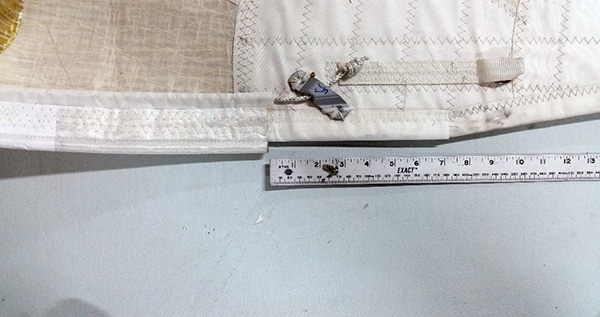
Typically when a sail is designed, the largest amount of draft at a given position of the sail is at about 45% of the way aft of the luff towards the leech. As the sail gets older, a couple of things can happen that move the draft of the sail closer to 50% or more, making it more and more difficult to trim and to steer the boat to. The other issue with the draft position is that it gets a lot “fuller” than originally designed, making it difficult to de-power the sail as the wind strength gets stronger. Here are some ways that we like to give your old sail a “face-lift.”
Luff Rope Shrinkage
One of the biggest causes of the draft position changing is when the rope on the luff of a mainsail or genoa shrinks. When a luff rope is attached to a sail it has to be given a small amount of tension in order to take the load that the halyard or Cunningham has applied to it.
Over time this rope can eventually shrink, making it very difficult to apply the correct tension on the luff. This will make the sail seem fuller, moving the draft aft on the sail. What we like to do in this scenario then is to essentially “ease” a portion of the tension of the rope.
This is done in two different ways. If the rope is free floating in the luff tape, held in place by hand stitching at the head and tack, then we can unstitch the hand stitching and ease the tension in the rope and hand sew it in its new position.
Typically, the rope is not free floating, which in that case we have to unstitch almost the entire luff tape to re-tension it. Then we apply back on the sail and re-sew it.
Luff Re-shape
Over time the material of the sails will stretch. This will cause the draft to become fuller than originally designed, even with the correct amount of luff tension. What we like to do here is re-shape the luff roach.
To some, the luff of the sail may seem like a straight line, but this actually is not the case, it has a positive arc running from the head to the tack. This, along with the broad-seaming of the sail, is one of the methods used to create shape in the sail. To help alleviate the fullness in the sail we then essentially reduce this roach using a long batten along the luff to create a new luff shape, but with a similar arc as was originally designed.
Over time and continuous use, your sails will start to show their age and lose some of their performance. Drop them off at your local Quantum loft and we can help bring them back to their original glory.
This cruising tip was brought to you by Quantum Sails








